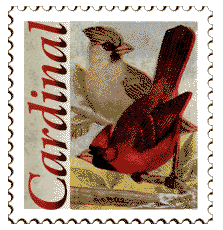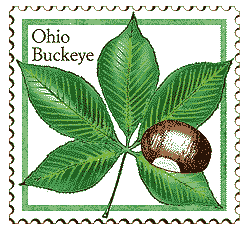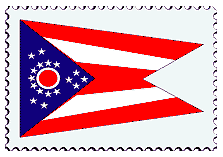
State Flower:
Scarlet Carnation
The red carnation was adopted as Ohio's State Flower in 1904 in memory of native son, President William McKinley, who always wore a red carnation in his lapel. McKinley was assassinated in 1901 while in office.

State Bird:
Cardinal
In 1933 the General Assembly adopted the Cardinal as the official State Bird because its song is strong and beautiful while its brilliant red plumage and high crest make it a dignified symbol.

State Tree:
Buckeye
Native to Ohio, the Buckeye Tree got its name due to its seed, which resembles the color, size and shape of a buck's eye. It was adopted as the State Tree in 1953.

State Flag:
Similar to the Cavalry guidon carried during the Civil War, this state flag is the only one in the shape of a burgee, the type of flag usually used on yachts. The red, white and blue colors are borrowed from the American flag. The seventeen stars show Ohio's rank as the seventeenth state to join the union. The large letter O stands for Ohio, and the red disk in its center represents the large Buckeye seed from the state tree. These seeds were so named because they looked like the eyes of the white-tailed buck deer.

Famous Person:
William Howard Taft
He was born on September 15, 1857 in Cincinnati, the son of a well-established, well-connected family. His father, Alonzo, was regarded as the "first citizen of Cincinnati." William Taft had grown up in the lifestyle befitting a gentleman. He studied law at Yale and harbored a dream of becoming Chief Justice of the Supreme Court. He realized that dream, but not until after he had first served as Governor of the Philippines and Secretary of War under his good friend, President Theodore Roosevelt. Later Taft was hand-selected by Teddy Roosevelt to become his successor in the presidential race of 1908. Taft won the election, but unfortunately lost his friend, Teddy, who turned grizzly when Taft didn't become the Roosevelt clone that was expected of him. Their friendship was destroyed completely when Roosevelt formed his own Progressive party and ran against Taft in the following election of 1912. The party split gave the majority vote to Woodrow Wilson. Nine years later, in 1921, President Harding appointed Taft as Chief Justice of the Supreme Court and Taft finally achieve his lifelong goal. He was the only man in history to ever hold both offices, Chief Executive and Chief Justice.